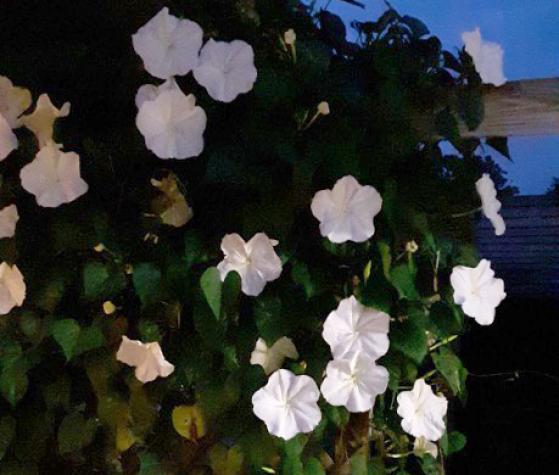MARYVILLE, Mo. – Twilight gardens delight the senses of sight and smell by adding another dimension to the gardening experience, says Gwen Funk, University of Missouri Extension horticulture specialist.
Also known as moon gardens, twilight gardens use white flowers and plants to capture reflected moonlight. “The use of the color white showcases how we can, with planning, extend our garden enjoyment into the evening,” Funk says.
Using moonglow to reflect off white flowers is not new. In Massachusetts in the 1830s, Benjamin Poore created a landscape of white flowers, including daffodils and honeysuckle. He also included white dogs, sheep, cows and other animals.
In the 1930s, Vita Sackville-West created a “white garden” at Sissinghurst Castle in England. She used white stone and flowers such as delphinium, foxglove, hydrangea and artemisia.
Plants with white flowers or white, silvery or variegated leaves transform a daytime garden into a tranquil moon garden, Funk says. Add another sensory element by planting fragrant night-blooming flowers within existing beds or pots.
Consider varying textures, forms and silhouettes by including grasses, flowers, vines, shrubs and trees, she says. The color palette should include white, ivory, pale yellow, lavender, silver and gray for the lightest reflection.
Additionally, place a water feature in your twilight garden to add the sound of trickling water. A small pool with floating white water lilies will reflect moonlight and add interest. “If you use artificial lighting for walkways or uneven surfaces, keep it subdued and aim for amber colored light instead of blue to avoid confusing nighttime pollinators,” Funk says. “Add comfortable seating so you can sit and absorb this wonderful sensory experience.”
Night bloomers attract often overlooked but important pollinators, including unique moths, beetles, flies and bees, she says.
Probably the most famous moon garden plant is moonflower, which is part of the morning glory family. Its huge, fragrant white flowers open at twilight. It blooms for most of the growing season and can form climbing vines up to 10 feet long.
Jennifer Schutter, MU Extension horticulture specialist in Adair County, has grown moonflowers from seed for several years. In the past, she planted them in May, but they didn’t bloom until September. This year, she planted the seed indoors in April, transplanted them outside in May and had blooms by late June.
If you are creating a garden from scratch, late summer to early fall is a great time to plant, says Funk.
Choose a location that is open to moonlight but close to the house so you can enjoy the flowers’ fragrance. Keep in mind that these flowers are part of your overall garden and think about how they look during the day.
Fragrant plant choices include lilacs, peonies, daylilies, jasmine, honeysuckle and mock orange. Plants with silvery foliage include dusty miller, pussy toes, some varieties of sage and lavender and artemisia.
A native flower that is essential to nighttime pollinators is Missouri evening primrose. This showy yellow flower opens in late afternoon and remains open through the night. The twilight glow showcases this important pollinator host plant.
As you choose your plants, remember, “the right plant in the right place,” says Funk. Environmental factors such as soil, sunlight, wind and water availability are still important. Choose varieties that are not considered invasive or noxious weeds, and plant in groups for the most impact.
Go to Twilight Gardens for more tips from MU Extension state horticulturist David Trinklein.
Photos
Moonflower
Moonflower. Photo courtesy of Jennifer Schutter, MU Extension.
Moonflower
Moonflowers closed during the day. Photo courtesy of Gwen Funk, MU Extension.
Hydrangea
Limelight hydrangea will glow at night. Photo courtesy of Gwen Funk, MU Extension.
